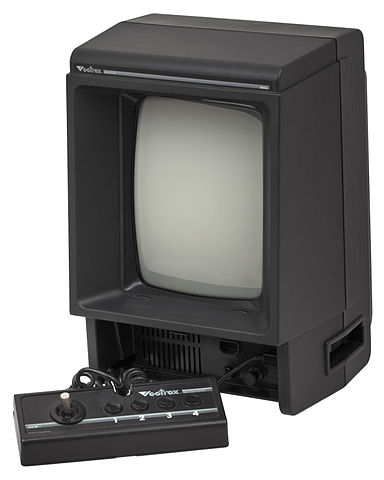Introduction
Behold, the Vectrex:

Image: Evan-Amos, CC BY-SA 3.0
This little gem is nice bit of video game history. It's a video game console that, with its built-in monochrome vector screen, was a bit of an oddball amongst all the video game consoles of its generation: the Atari 2600, Intellivision, Colecovision and the rest all connected to a TV to display their graphics. The Vectrex is different: it has a built-in CRT on which it displayed crisp vector graphics in clear lines that aren't limited by any raster sizes. Unfortunately, it only saw the light of day in 1982, just one year before the video game crash of 1983 set in, and in early 1984 production of the Vectrex consoles stopped.
The Vectrex uses simple, but still pretty powerful hardware. It has an 1.5MHz 6809 processor, which has a few nice features over the 6502 processors that were mostly used around that time. It has 1K of internal RAM and 8K of ROM, which is partially filled with the built-in game Minestorm. The vector drawing hadware is analog and uses a single 8-bit DAC that's multiplexed to provide the X and Y velocities of the lines that are drawn. It's also multiplexed to the sound circuit, so rudimentary digital sounds can be produced if the developer wants to; it was, however, more popular to use the AY-3-8912 3-channel sound chip to make tunes and bleeps and blips.
I obtained a Vectrex some years ago. It's the only console of that generation I own, mostly because the built-in CRT and analog logic make it one of the harder things to emulate on a PC, and because I like the way it works: I'm a sucker for vector graphics. So, when I saw one in a game shop with a sticker "Demo unit, does not work!", I had to inquire if I could take it. 50 euros later, I had a functioning Vectrex at home: probably the previous owner just messed with the image intensity knob and thought the thing was dead.
Ofcourse, after playing Minestorm for
the umpteenth time, I decided I wanted to also play some other games and I whipped up a quick
multigame cartridge with a piece of double-sided PCB and a Dremel. It's not the nicest thing I ever
built, but it worked:
This cartridge is one of the more rudimentary multicarts you can make: electrically, it's nothing more than a 512KByte flash ROM with the upper address lines connected to a DIP switch. The idea is that the flash ROM is filled with concatenated game ROM images, and by flipping the DIP switches, you can select which part of the flash ROM (and thus, which game) the Vectrex sees.
When I recently wanted to take out my Vectrex for a spin again, I found the multicart was in a bad state: not only had it not kept well mechanically, I also didn't have the flash programmer anymore to replace the games on it. Also, the DIP switches always were a pain in the arse: you had to remember what setting corresponded to what game and you had to get the cartridge out of the Vectrex because otherwise you couldn't change the settings.
With all that, I decided it was time to make a new flash cartridge. One that was in all respects better than the one I had, with more memory, easier reprogrammability, easier selection of games and better mechanics.
1 Next »